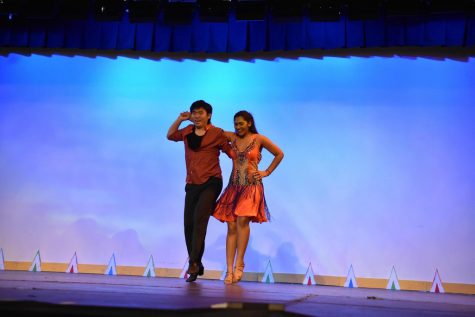So you wanna be a ballroom dancer?
November 16, 2017
While training in California, professional ballroom dancer Andrea Faraci found himself in need of a dance partner and finally got a response after reaching out to his teachers back in Italy. The wife of one of his coaches came into contact with Iveta Faraci, who lived in Lithuania at the time and was also searching for a partner.
“We decided to do a tryout, and we did that at Blackpool in England,” Andrea said. “We really liked how [the tryout] went, and our coaches loved it. From that moment on, Iveta decided to move to America to join me, and we started to dance together.”
Three years after meeting, the dancers became engaged.
Even though they were both raised in different parts of Europe, Andrea and Iveta grew up surrounded by families, friends and coaches who loved ballroom dancing.
Born and raised in Milano, Italy, Andrea started pursuing his dream at only five years old. At the age of 18, he ventured out to the U.S. to dance professionally. In America, he won several competitions, becoming the US Amateur Ballroom Champion and also winning the National Ballroom Championship.
Iveta, who grew up in Lithuania, also dedicated herself to setting the foundations for her career from a very young age. After school everyday, she would attend intense five-hour dance lessons. She then taught dance in Hong Kong for a few years to earn money and performed in a season of Dancing With the Stars Lithuania before moving to America.
“[I was] trained professionally when I was very little,” Iveta said. “By the time I was 10 years old, I already knew that my career would be in dance.”
England hosts three main ballroom dancing competitions including the Blackpool Championship, the most prestigious competition in the world. In one year, Andrea and Iveta participated in around 36 competitions, traveling to England around once a month for five or six days at a time.
“When we used to compete, we would wake up in the morning, go to the gym, go to practice for two or three hours and then we would teach [our students] all day,” Iveta said.
Andrea and Iveta no longer participate in such prestigious competitions, and currently, they own the Starlite Ballroom dance company, located in San Jose, California.
After competing and teaching for many years in America, the dancers noticed the many aspects of ballroom dance that differed in Europe. In America, teachers allow casual dance clothing, whereas in Europe, most dance teachers require a specific attire for their students. He recalled that while in Italy, there was an occasion where he did not bring his tie to his lesson, and his instructor refused to teach him for the rest of the class.
American ballroom dance teaching technique and European technique differ in discipline as well. Iveta stressed that in Lithuania, her teachers would train the students using hardcore strategies similar to the military.
“For example, if you would stretch your leg and it wasn’t straight, they would hit you,” she said. “Not hard or anything, but it was very strict. My coaches were so strict in the lesson, but they were also my best friends outside the lesson.”
Although perfectly in sync with one another while dancing, the couple offered differing opinions regarding their favorite part about dancing.
“I actually like the music,” Andrea said. “Like expressing your body to the music, I think it’s really beautiful.”
Iveta laughs, admitting that her favorite aspect of dancing remains winning.
The one piece of advice that Iveta would give to aspiring young dancers includes being a good actor. She emphasizes that nerves come naturally to all performers and encourages displaying a confident image when dancing.
Andrea believes that ballroom dancers can only truly succeed with patience and time.
“I remember having a lesson with my teacher one day, and I was extremely unhappy about a step,” Andrea said. “[My teacher] looked at me and asked me if I thought he was stupid, and I said I never thought that. He said, ‘If it took me 40 years to learn this step, why should it take you a couple of minutes?’”
A Spotlight on Riya Chandra (’17)
Riya Chandra (‘17) began her first ballroom dance lesson at the end of her sophomore year after several dancers on the show Dancing With the Stars inspired her. Ever since the beginning of her junior year at the upper school, she has performed in many pro/am competitions with her coach. Pro/Am is a popular ballroom dancing system in which a professional and an amateur dance together.

Timothy Wang (10) and Riya Chandra (12) dance to the song “Great Balls of Fire” by Jerry Lee Lewis. This routine was the only jive number in last year’s dance production.
As a senior, Riya performed at the upper school dance production in a duet with junior Timothy Wang, dancing to “Great Balls of Fire” by Jerry Lee Lewis. She says that performing and competing are very different experiences because competing involves many people dancing at one time on a large stage.
“I went to take a lesson, and I didn’t know if I would like it or not, but it was super cool, and it was unlike any other dancing I had ever done,” Riya says. “This is just so different because you are with a partner. I immediately fell in love.”
This piece was originally published in the pages of The Winged Post on November 16, 2017.


















![“[Building nerf blasters] became this outlet of creativity for me that hasn't been matched by anything else. The process [of] making a build complete to your desire is such a painstakingly difficult process, but I've had to learn from [the skills needed from] soldering to proper painting. There's so many different options for everything, if you think about it, it exists. The best part is [that] if it doesn't exist, you can build it yourself," Ishaan Parate said.](https://harkeraquila.com/wp-content/uploads/2022/08/DSC_8149-900x604.jpg)




![“When I came into high school, I was ready to be a follower. But DECA was a game changer for me. It helped me overcome my fear of public speaking, and it's played such a major role in who I've become today. To be able to successfully lead a chapter of 150 students, an officer team and be one of the upperclassmen I once really admired is something I'm [really] proud of,” Anvitha Tummala ('21) said.](https://harkeraquila.com/wp-content/uploads/2021/07/Screen-Shot-2021-07-25-at-9.50.05-AM-900x594.png)







![“I think getting up in the morning and having a sense of purpose [is exciting]. I think without a certain amount of drive, life is kind of obsolete and mundane, and I think having that every single day is what makes each day unique and kind of makes life exciting,” Neymika Jain (12) said.](https://harkeraquila.com/wp-content/uploads/2017/06/Screen-Shot-2017-06-03-at-4.54.16-PM.png)








![“My slogan is ‘slow feet, don’t eat, and I’m hungry.’ You need to run fast to get where you are–you aren't going to get those championships if you aren't fast,” Angel Cervantes (12) said. “I want to do well in school on my tests and in track and win championships for my team. I live by that, [and] I can do that anywhere: in the classroom or on the field.”](https://harkeraquila.com/wp-content/uploads/2018/06/DSC5146-900x601.jpg)
![“[Volleyball has] taught me how to fall correctly, and another thing it taught is that you don’t have to be the best at something to be good at it. If you just hit the ball in a smart way, then it still scores points and you’re good at it. You could be a background player and still make a much bigger impact on the team than you would think,” Anya Gert (’20) said.](https://harkeraquila.com/wp-content/uploads/2020/06/AnnaGert_JinTuan_HoHPhotoEdited-600x900.jpeg)

![“I'm not nearly there yet, but [my confidence has] definitely been getting better since I was pretty shy and timid coming into Harker my freshman year. I know that there's a lot of people that are really confident in what they do, and I really admire them. Everyone's so driven and that has really pushed me to kind of try to find my own place in high school and be more confident,” Alyssa Huang (’20) said.](https://harkeraquila.com/wp-content/uploads/2020/06/AlyssaHuang_EmilyChen_HoHPhoto-900x749.jpeg)






